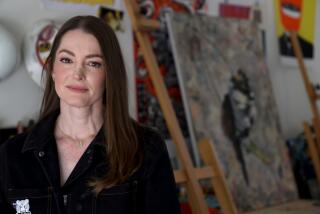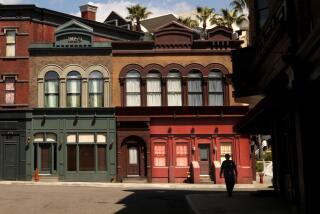Television News: Stay Tuned for a Brand-New Set
- Share via
KCBS-TV anchor Michael Tuck is working on his fourth set in eight years at Channel 2, a sleek black and wood model featuring a miniature re-creation of the Los Angeles skyline in the background.
If tradition holds, KCBS will probably demolish the expensive set before long, especially now that the general manager who commissioned it abruptly left in September after just two years with the station.
In TV news, as executives come and go, the life expectancy of any particular grouping of desks, chairs and mood lighting is about three to four years.
The ever-increasing disposal rate of sets is good news for the small, little-known group of companies dedicated to designing and building news sets. By all accounts, their business is booming.
Around the country, stations have been launching news operations at a record pace--more than 50 Fox Network affiliates in the last two years alone--fueling the already overheated local news competition. Stations are revamping and retooling their sets, including KABC-TV (Channel 7) and KCOP-TV (Channel 13) in Los Angeles this fall.
Although most executives acknowledge that a new set is unlikely to boost ratings, a set make-over is still seen as a quick way to spruce up a station’s image. A set costs between $250,000 and $1 million, which may be a worthwhile investment for a third-place news operation with a $10-million budget and a news reader making $1 million a year.
The number of set-design firms has doubled in recent years, with at least six of them competing for business in Southern California. Established news set designers say their revenues have doubled in the last three years.
“Business is good,” said Gil Jimenez, a 20-year veteran of set building who runs his own company, Gil Jimenez Broadcast Design in Vista. “We’re moving into the new millennium and stations want to look good.”
Jimenez was a partner in G&G; Designs, a San Diego firm that once had the set-design market virtually to itself before breaking up in 1990. G&G; grew to more than 50 employees in an era when stations decided, seemingly en masse, that their sets looked “rinky-dink,” Jimenez said.
Today the market is dominated by half a dozen small companies of five to 15 employees, specializing in everything from camera angles to seat-cushion fabrics. With the growth of local news, the top set-design firms are able to generate $3 million to $5 million a year in revenue.
Most build the sets themselves, offering turn-key service on every aspect of the production. Many of the firms are known for a particular design or color scheme.
Hot sets tend to get copied, and news executives and consultants have favorite designers for different projects. When KTLA (Channel 5) redesigned last year, it used Broadcast Design International for the newsroom and Devlin Design Group for the studio set--two San Diego County-based firms that grew out of G&G; Designs.
For its new set, unveiled in September, KABC-TV used NewSet, a 4-year-old company with 10 employees based in Los Angeles. Chief Executive Brett Walker worked in furniture construction before starting the company, which has built sets for VH1, in addition to local stations around the country. KABC’s 10-year-old set was “old, cold and drab,” said station General Manager Arnold Kleiner, who took the reins at KABC in 1996.
The new set is 6,000 square feet, housing both the morning and evening news desks, as well as a special weather set and a huge, state-of-the-art rear-projection television monitor. It also has a mural backdrop of Los Angeles to rival KCBS’ skyline.
“If you do a set right, it makes you look like the market,” Kleiner said.
KCBS, seeking a different look, purposely avoided the traditional news set builders and hired Cinnabar California Inc., a Burbank-based specialist in Hollywood set construction and models, to build its three-dimensional background, complete with lighting that changes for different times of the day.
In the news set business, designs and gimmicks move in and out of vogue. Over the years, interview “pits,” gratuitous plants and video walls all have waxed and waned in popularity.
Big television monitors are hot these days, said Tim Saunders, president of Broadcast Design International, the 8-year-old company that has built sets for KTTV (Channel 11) and Fox Sports. So are two-story sets, “weather centers” and rail-thin plasma screens.
When Broadcast Design built the new set for “CBS Nightly News,” anchor Dan Rather wanted a special tunnel installed under the set so his producer could inconspicuously hand him notes during newscasts, Saunders says.
But designers say that despite the technical advances and new, “warmer” colors, there has been little change in the basic concept of two anchors sitting behind a desk with the weather person on the left and the sports guy on the right.
A few years ago, KCOP began broadcasting live from its newsroom with anchors walking from desk to desk. After mixed reviews and bad ratings, it switched back to a traditional desk format. Its new set, designed by another San Diego firm, Express Group, will stick to that basic format.
And while the high-tech look may be in, radical is out.
Stations “want to be very with-it and modern, but they don’t want to do anything to alienate core viewers,” said Jim Fenhagen, a partner in New York-based Production Design Group, which created a buzz with its high-tech sets for MSNBC and NBC’s “Dateline.”
“You can’t go too far,” he said.
Even designers of “virtual” sets, computer-generated environments that can be changed almost instantaneously, have toned down the Space Age aspects, keeping the traditional desks and backdrops.
“No more anchors in space,” said Dan Devlin of Devlin Design Group. “Our push for virtual reality is not the bells and whistles, it’s the versatility.”
Virtual sets have been touted for years, but they have been slow to win over producers, outside of a few special event sets and sports programs. However, hardware and software costs are dropping. A virtual set system that would have cost $1 million two years ago would now run closer to $350,000, set builders say.
To offer virtual sets, Devlin is partnered with Discreet Logic, a maker of digital editing equipment that was purchased in August for $520 million by Autodesk. Devlin recently signed a deal with the Warner Bros. affiliate in Little Rock, Ark., to make it one of the first all-virtual stations in the country.
Although some still think the futuristic sets look “cartoonish,” Broadcast Design’s Saunders said virtual sets, which generate almost no business for his company now, will account for 30% of his revenue within two years.
The advent of digital television, which will offer much more sharply defined pictures, has many stations scrambling to update their sets.
“You’ll be able to see every wart,” Jimenez said.
More to Read
The biggest entertainment stories
Get our big stories about Hollywood, film, television, music, arts, culture and more right in your inbox as soon as they publish.
You may occasionally receive promotional content from the Los Angeles Times.










